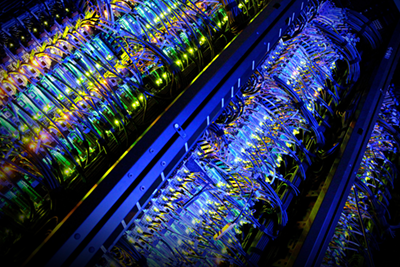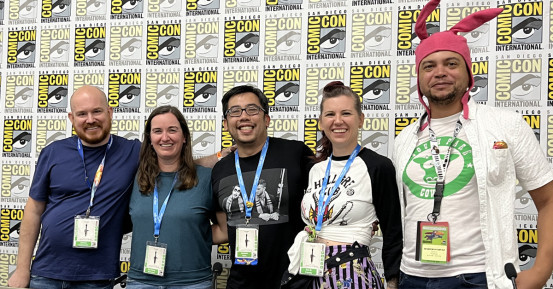UC San Diego Receives $4.4M from NIMH for Brain Imaging Data “Gateway”
Partnering with Stanford University, UC San Diego researchers will create the Neuroelectromagnetic Data Archive and Tools Resource at San Diego Supercomputer Center
Published Date
By:
- Michelle Franklin
Share This:
Article Content
University of California San Diego has been awarded $4.4 million from the National Institute of Mental Health (NIMH) to create the Neuroelectromagnetic Data Archive and Tools Resource (NEMAR). The project is a part of the BRAIN Initiative, a public-private partnership funded through the National Institutes of Health. NEMAR will be a collaboration between the university’s Swartz Center for Computational Neuroscience at the Institute for Neural Computation and San Diego Supercomputer Center (SDSC), and Stanford University’s Center for Reproducible Neuroscience.
Scott Makeig, director of the Swartz Center for Computational Neuroscience, is the principal investigator (PI) on the grant. Arnaud Delorme, project scientist at the Swartz Center, and Amitava Majumdar, director of SDSC’s Data-Enabled Scientific Computing division, are co-PIs alongside Russell Poldrack, the Albert Ray Lang Professor of Psychology at Stanford University.
“This level of cutting-edge multidisciplinary research collaboration is what UC San Diego is known for,” says Chancellor Pradeep K. Khosla. “NEMAR has the potential to deepen the scope of data science, clinical research and patient care. Combining the expertise and insight of neuroscientists and computer scientists is one way we are advancing the frontiers of knowledge and discovering new ways to enhance lives everywhere.”
NEMAR will act as a portal or gateway to the OpenNeuro data archive created by Poldrack and his team. OpenNeuro is a free and open platform that allows researchers to upload and share neuroimaging data. Submitted datasets can then be analyzed by anyone who logs in. OpenNeuro has been designated by the NIMH as a repository for data collected from BRAIN Initiative projects as well as other types of human neuroimaging data; however, to date workflows only exist for fMRI data. This means that even if other types of brain scans were uploaded to OpenNeuro, there is no infrastructure in place for data analysis.
NEMAR will build the infrastructure and tools necessary to add human neuroelectromagnetic brain imaging to the archive, including EEG (electroencephalography) and its magnetic counterpart, MEG (magnetoencephalography). This brain data will be uploaded through the NEMAR portal to SDSC. After NEMAR software evaluates the quality of the data and the completeness of its documentation, it will be added to the OpenNeuro archive.
The project will also provide data visualization tools for OpenNeuro users. To do this, NEMAR will use the Neuroscience Gateway (NSG), operated through the National Science Foundation-funded Extreme Science and Engineering Discovery Environment (XSEDE), a national network of supercomputers and other high-performance computing and expertise. SDSC is home to Comet, a petascale supercomputer capable of some 2 quadrillion operations per second and part of the XSEDE program.

Close-up of Comet supercomputer at SDSC.
In the future, NSG users may also be able to work on OpenNeuro data ported to SDSC’s XSEDE resources via a high-bandwidth pipe between SDSC and commercial cloud providers such as Amazon, where the OpenNeuro data now resides. Alternatively, a copy of the neuroelectromagnetic data archived in OpenNeuro may be stored at SDSC to facilitate further processing.
Data streams uploaded through the gateway will be uniformly formatted using BIDS (Brain Imaging Data Standard) and included HED (Hierarchical Event Descriptor) standards. This uniformity will allow researchers to apply new statistical machine-learning approaches to uncover hidden patterns that can be found only by searching across large amounts of data, likely leading to new insights in basic and clinical brain research.
The organization of neuroscience data, known as neuroinformatics, is a relatively new field of research that holds great promise in patient care. With enough analyzable data, researchers may be able to extract robust biomarkers allowing for the precise diagnosis and treatment of neurological disorders.
Makeig is excited about the potential reach of this project, stating, “NEMAR will help us learn more about how brain dynamics support thought and action, and can therefore be a catalyst for advancing brain science and clinical brain research.”
The "Brain Initiative Resource: Development of a Human Neuroelectromagnetic Data Archive and Tools Resource (NEMAR)" project is funded by the National Institute for Mental Health under the BRAIN Initiative (grant 1R24MH120037-01).
Share This:
Stay in the Know
Keep up with all the latest from UC San Diego. Subscribe to the newsletter today.



